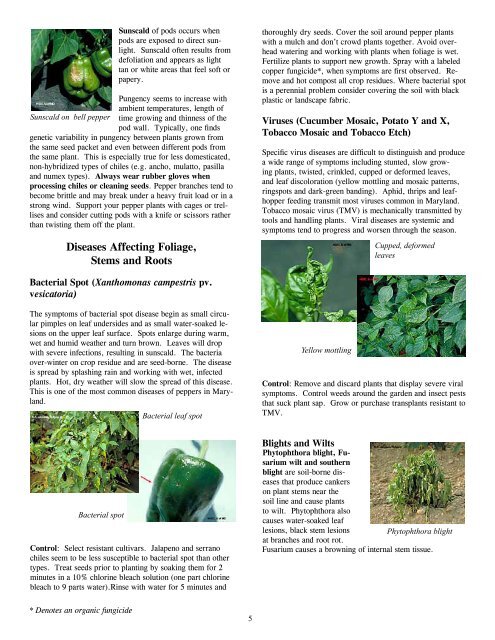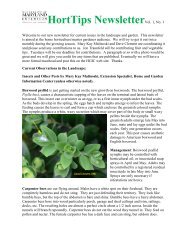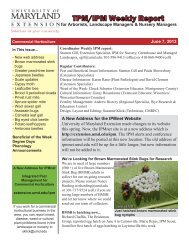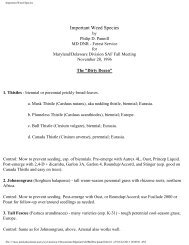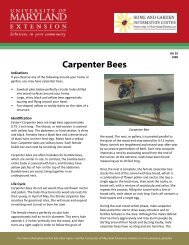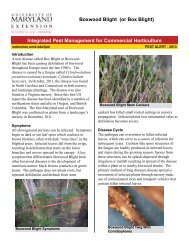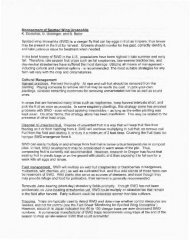IPM Series: Peppers (HG 57) - University of Maryland Extension
IPM Series: Peppers (HG 57) - University of Maryland Extension
IPM Series: Peppers (HG 57) - University of Maryland Extension
Create successful ePaper yourself
Turn your PDF publications into a flip-book with our unique Google optimized e-Paper software.
Sunscald <strong>of</strong> pods occurs when<br />
pods are exposed to direct sunlight.<br />
Sunscald <strong>of</strong>ten results from<br />
defoliation and appears as light<br />
tan or white areas that feel s<strong>of</strong>t or<br />
papery.<br />
Pungency seems to increase with<br />
ambient temperatures, length <strong>of</strong><br />
Sunscald on bell pepper time growing and thinness <strong>of</strong> the<br />
pod wall. Typically, one finds<br />
genetic variability in pungency between plants grown from<br />
the same seed packet and even between different pods from<br />
the same plant. This is especially true for less domesticated,<br />
non-hybridized types <strong>of</strong> chiles (e.g. ancho, mulatto, pasilla<br />
and numex types). Always wear rubber gloves when<br />
processing chiles or cleaning seeds. Pepper branches tend to<br />
become brittle and may break under a heavy fruit load or in a<br />
strong wind. Support your pepper plants with cages or trellises<br />
and consider cutting pods with a knife or scissors rather<br />
than twisting them <strong>of</strong>f the plant.<br />
Diseases Affecting Foliage,<br />
Stems and Roots<br />
thoroughly dry seeds. Cover the soil around pepper plants<br />
with a mulch and don’t crowd plants together. Avoid overhead<br />
watering and working with plants when foliage is wet.<br />
Fertilize plants to support new growth. Spray with a labeled<br />
copper fungicide*, when symptoms are first observed. Remove<br />
and hot compost all crop residues. Where bacterial spot<br />
is a perennial problem consider covering the soil with black<br />
plastic or landscape fabric.<br />
Viruses (Cucumber Mosaic, Potato Y and X,<br />
Tobacco Mosaic and Tobacco Etch)<br />
Specific virus diseases are difficult to distinguish and produce<br />
a wide range <strong>of</strong> symptoms including stunted, slow growing<br />
plants, twisted, crinkled, cupped or deformed leaves,<br />
and leaf discoloration (yellow mottling and mosaic patterns,<br />
ringspots and dark-green banding). Aphid, thrips and leafhopper<br />
feeding transmit most viruses common in <strong>Maryland</strong>.<br />
Tobacco mosaic virus (TMV) is mechanically transmitted by<br />
tools and handling plants. Viral diseases are systemic and<br />
symptoms tend to progress and worsen through the season.<br />
Cupped, deformed<br />
leaves<br />
Bacterial Spot (Xanthomonas campestris pv.<br />
vesicatoria)<br />
The symptoms <strong>of</strong> bacterial spot disease begin as small circular<br />
pimples on leaf undersides and as small water-soaked lesions<br />
on the upper leaf surface. Spots enlarge during warm,<br />
wet and humid weather and turn brown. Leaves will drop<br />
with severe infections, resulting in sunscald. The bacteria<br />
over-winter on crop residue and are seed-borne. The disease<br />
is spread by splashing rain and working with wet, infected<br />
plants. Hot, dry weather will slow the spread <strong>of</strong> this disease.<br />
This is one <strong>of</strong> the most common diseases <strong>of</strong> peppers in <strong>Maryland</strong>.<br />
Bacterial leaf spot<br />
Yellow mottling<br />
Control: Remove and discard plants that display severe viral<br />
symptoms. Control weeds around the garden and insect pests<br />
that suck plant sap. Grow or purchase transplants resistant to<br />
TMV.<br />
Bacterial spot<br />
Control: Select resistant cultivars. Jalapeno and serrano<br />
chiles seem to be less susceptible to bacterial spot than other<br />
types. Treat seeds prior to planting by soaking them for 2<br />
minutes in a 10% chlorine bleach solution (one part chlorine<br />
bleach to 9 parts water).Rinse with water for 5 minutes and<br />
Blights and Wilts<br />
Phytophthora blight, Fusarium<br />
wilt and southern<br />
blight are soil-borne diseases<br />
that produce cankers<br />
on plant stems near the<br />
soil line and cause plants<br />
to wilt. Phytophthora also<br />
causes water-soaked leaf<br />
lesions, black stem lesions Phytophthora blight<br />
at branches and root rot.<br />
Fusarium causes a browning <strong>of</strong> internal stem tissue.<br />
* Denotes an organic fungicide<br />
5


